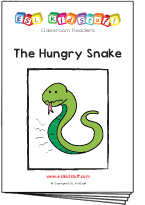Past tense activities – Irregular verbs: Part 2 lesson plan
Stand-alone lesson ESL kids lesson plan
Lesson plans for ESL kids teachers
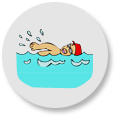
Past tense activities – Irregular verbs: Part 2
In this lesson students practice using the past simple tense with 16 common irregular verbs – this lesson follows the last lesson plan on past irregular verbs. Students continue to practice talking about what they did yesterday, do some fun activities, sing a song and make a story poster.
Members get accompanying flashcards, worksheets, song and classroom reader.
Download materials:
Our lesson plans are FREE!
Sign up for accompanying:
✔ worksheets
✔ homework sheets
✔ craft sheets
✔ flashcards
✔ song downloads & videos
✔ classroom readers & videos
Click to see lesson details, materials and supplies
Time: 40 mins – 1 hour
Objectives: Saying the present and past forms of irregular verbs.
Structures: “What did you do yesterday?”, “Yesterday, I …(verb)”.
Target vocabulary: woke up, ate, drank, went, sang, swam, had, came back, rode, did, put on, slept, gave, wrote, read, ran.
Lesson materials
Flashcards:
- wake up, eat, drink, go to school, sing, swim, star jump (we’ll use this for “have fun”), go home (use for “come back home”), ride a bike, do homework, put on, sleep, give, write, read, run.
Printables:
- Past irregular verbs 2 worksheet
- My day yesterday worksheet
- Reader worksheet
- Past irregular verbs song poster
Songs:
- What did you do yesterday? (Past irregular verbs)
- Past irregular verbs song
Readers:
- Mr. Upside Down Man’s busy day
Additional materials:
- Past activities 2 vocab crossword
- Past activities 2 vocab word search
- Past tense match (Irregular 2) worksheet
Supplies:
- [hide_on_uk]colored[/hide_on_uk][hide_on_us]coloured[/hide_on_us] pencils
- string or rope and 12 clothes pegs (or large paper clips)
- Blu-Tack or tape to stick flashcards to the board
- large sheets of paper (e.g. A3) or construction paper / card (enough for 1 sheet per each pair of students)
- lots of old magazines, [hide_on_uk]catalogs[/hide_on_uk][hide_on_us]catalogues[/hide_on_us], newspapers, etc.
- board with marker / chalk
- device to play the song on
In this lesson students will continue to practice using the past simple tense with some common irregular verbs.
IMPORTANT: This lesson should be taught after Past tense activities – Irregular verbs: Part 1.
Lesson procedure:
Warm up and maintenance:
The beginning of your lesson is extremely important: this is where you set the tone of your lesson and get everyone in the right frame of mind for learning English. It is also an opportunity to check homework and review previous lessons.
Click for warm up suggestions for the start of your lessons
These activities can be done in the following order at the start of your lesson:

1. Greetings and name tags
Greet the students by name as they enter the classroom and gesture for them to sit down. Before class prepare some blank name tags (stickers or pin-on tags). Give these out and have everyone write their names and put their tags on. If you use pin-on tags, you can keep and give out every class.

2. Homework check
Check each student’s homework set in the last lesson. Ask each student some questions about their homework worksheet (e.g. “what [hide_on_uk]color[/hide_on_uk][hide_on_us]colour[/hide_on_us] is it?”), give lots of praise, and then put some kind of mark on the homework sheet (e.g. a sticker, a stamp or draw a smiley face). Finally, tell your students to put their homework back into their bags.
3. Review past lessons
Reviewing past lessons is very important – students need constant practice of new vocab, structures, songs, games and so on. Always review parts of your last lesson as well as some parts from other previous lessons. You can spend 5-10 minutes reviewing – it’s fine to recycle games and activities from your past lessons to review as kids enjoy playing familiar games (although be careful not to play a game to death!). See the section “Other ideas to include in your warm” below for ideas.
You can also include review activities in the main body of your lesson. Kids can have short attention spans so it’s good to be able to pull out lots of activities during different stages of the lesson.
Other ideas to include in your warm up:
Ball pass questions
This is good to review questions from previous lessons. Get everybody standing in a circle.
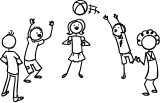
Round 1:
Take a ball and hold it and say, “My name is (you name)”. Then throw the ball to one student and say, “What’s your name?”. Students throw the ball around randomly, saying their names and asking for names.
Round 2:
This time ask a review question, e.g. “How many tables are there?”. Then throw the ball to a student who should answer, “There are (6) tables”. Help if necessary. Then that student throws the ball to another student and asks a “How many …?” question. Continue so everyone has a go. You can have multiple rounds with different topic questions.

Play “Spin the bottle”
Sit students in a circle with a bottle in the middle. Teacher spins the bottle. When it stops spinning the student it is pointing to has to answer a question. If the answer is correct then that student can spin the bottle. This is a good class warm up activity (e.g. How are you? What’s your [hide_on_uk]favorite[/hide_on_uk][hide_on_us]favourite[/hide_on_us] food? How’s the weather today?, etc.
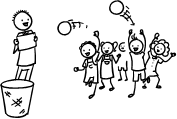
Play “Vocabulary basketball”
This is a fun game which reviews vocabulary from previous lessons. You will need a basket (a trash can) and 2 balls (or 2 pieces of A4 paper scrunched up into balls).
Form 2 teams and line them up so that two players from each team are facing the front with the basket in front of them. Let both players throw their ball – if they get their ball into the basket they can try and win a point by giving the correct answer to a question the teacher asks. This can be an actual question (e.g. What are you wearing?) or a flashcard (What’s this?). Then they go to the back of the line. At the end, the team with the most points is the winner!
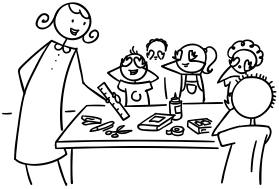
Play “What’s missing?”
This is a fun review memory game – students will have to try to remember review objects from previous lessons (e.g. classroom stationery). Lay the objects out on a table for all to see. Allow the students a minute to memorize the positions of the objects. Remove an object and hold it behind your back. Say, “Open your eyes!” – the first student who can shout out the missing object wins a point for his/her team. Play for all the objects.
Finally, calculate which team has won the most points and give them a round of applause.

Play “Quiz game show”
This is a fun quiz game, like a simple version of a TV game show. Draw some circles on the board and randomly write numbers 1, 2 or 3 in each circle. These will be points.
Put students into teams. Then ask the first team to choose a number – 1 is an easy question (e.g. “Do you like bananas?”) and 3 is a difficult question (e.g. point at a clock and ask, “What time is it?”). 2 will be in between in terms of difficulty. When the question has been answered correctly, erase that number circle. Play until all the number circles are gone – the team with the most points is the winner!
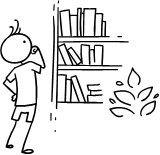
Read a classroom reader again
As you progress through the lessons you will start to build up a catalog of classroom readers (see our Readers download page at https://www.eslkidstuff.com). Kids love going back to old stories and reading through them again. Invite a student to pick a classroom reader and read through it as a class. Make the story as interactive as possible by asking questions (e.g. what [hide_on_uk]colors[/hide_on_uk][hide_on_us]colours[/hide_on_us] there are, the names of different objects, etc.) and getting students to speculate what is going to happen next in the story.
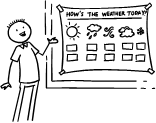
Talk about the weather (do after you have taught the weather lesson plan).
- Prepare a weather board. Before the first class prepare a piece of cardboard and cover it with felt – you are going to pin this to the wall. If you can, try and get blue felt (to represent the sky). Write at the top in large letters, “How’s the weather today?”. Below that write “Today it’s”. Cut out weather pictures (such as our weather flashcards) and stick some velcro on the back. Arrange the weather pictures around the edge of the board and then put the board on the wall of your classroom. You can now use this weather board at the beginning of every lesson.
- Ask about the weather. Ask, “How’s the weather today?” and have students put up their hands. Allow one weather condition per student (e.g. “It’s rainy”) and have each student come up and put a weather picture on the weather board.
- Introduce more weather vocabulary. Depending on weather conditions, you can introduce more weather words (with pictures … you can get students to draw them), such as:
- stormy
- misty
- showery
- freezing
- humid
- frosty
- icy
- drizzly
Review and practice:
1. Review past tense irregular verbs – play “Flashcards washing line”
In your last class your students learned 12 past tense irregular verbs – let’s start by reviewing these.
You’ll need some string or rope (a washing line) and 12 clothes pegs (you can also use large paper clips). String the rope across the classroom so it is at head height. Take the 12 flashcards from last lesson (wake up, eat, drink, go to school, sing, swim, star jump (we’ll use this for “have fun”), go home (use for “come back home”), ride a bike, do homework, put on, sleep) and hold up the first card. Elicit the verb and the past tense version (e.g. “wake up – woke up”) and peg it onto the washing line. Continue with all of the other 11 flashcards.
You can also use the flashcards past regular verb flashcards from the lesson “Past tense activities – Regular verbs” (the flashcards are play with friends, paint a picture, walk in the park, watch TV, jump in puddles, play games, kick a ball, dance).
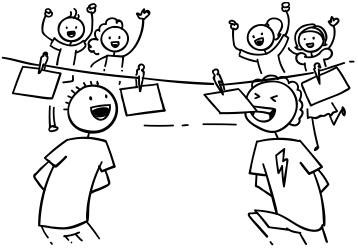
Next, place your students into 2 teams and form 2 lines in front of the washing line, with each student standing behind the other. You will therefore have two students at the front of their teams. The idea is for those two students to race to the washing line and grab a flashcard, but only using their mouths! They then race on to the other end of the classroom. The winner will score 1 point for their team. Start by shouting out two verbs in the past tense (e.g. slept and rode) and the first 2 students race, grab one of those cards in their mouths and race to the finish. They should then replace the card onto the line again. The next two students race for 2 new verbs, and so on, until everyone has had a turn. It is a really fun activity!
2. Sing the “What did you do yesterday?” song
We learned this song last in the last lesson so let’s sing it again as a fun review. Start by eliciting the gestures and then have everyone do the gestures as they sing along.
[hide_on_uk]Short sample (members get full-length song):
[/hide_on_uk]
[hide_on_us]Short sample (members get full-length song):
[/hide_on_us]
New learning and practice:
3. Teach 4 more irregular verbs
Get everyone to sit down. Stick the 12 irregular verb flashcards randomly onto the board. You will now teach 4 more verbs using a combination of actions and flashcards: give – gave, write – wrote, read – read, run – ran. Start by looking at the first flashcard, but don’t show it to the class. You are going to do the action and everyone has to shout out the answer:

- give – gave: hold out hands and give things to students (e.g. pens, crayons, books, etc.)
- write – wrote: write on the board or a piece of paper
- read – read: read a book, turning the pages
- run – ran: run on the spot
As you elicit / teach each verb, stick the card onto the board and write the forms under the flashcard (e.g. give – gave) and chorus 3 times.
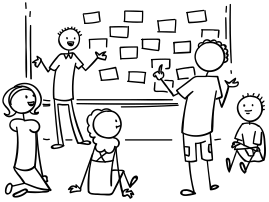
4. Do “Flashcard drill fun”
You should now have 16 cards on the board. We are going to practice drilling these cards using fun methods. It is important to keep it fast pacedand use a variety of methods so the drilling doesn’t get boring. Start by pointing at a card and saying the infinitive form of the verb – and get your students shouting out the past tense form, for example:
Teacher: (pointing to a card) eat.
Students: ate
Teacher: (pointing to another card) swim.
Students: swam
etc.
Continue at a fast pace and get faster and faster, making a game of it. Next, play some variations of the drill, such as:
- say each verb in different voices (low, high, loud, quite, monster voice, singing voice, etc.) and students have to reply in the same voice.
- split the class into 2 teams. The teacher points at a card – team A says the infinitive form and team B says the past tense form.
- students all stand up. Each time the teacher points at a student to say the past tense form. If s/he gets it correct s/he can sit down.
- students all close their eyes. The teacher removes a card and then says, “Open your eyes!” – the first student to shout out the missing card (in both infinitive and past forms) wins a point for his/her team.
- students must do gestures as well as shout out the past tense form of each verb.
5. Sing the “Past irregular verbs song”
The first time you play the song, put up the flashcards in order on the board or use the “Past irregular verbs song” song poster. Quickly elicit the vocab. Play the song and sing along doing the gestures, as described below in Gestures below. Play 2 or 3 times.
Lyrics for the “Past irregular verbs song”
La la la la la la – La la la la la la
Verse 1:
wake, wake, wake – woke, woke, woke
eat, eat, eat – ate, ate, ate
drink, drink, drink – drank, drank, drank
go, go, go – went, went, went
La la la la la la – La la la la la la
Verse 2:
sing, sing, sing – sang, sang, sang
swim, swim, swim – swam, swam, swam
have, have, have – had, had, had
come, come, come – came, came, came
La la la la la la – La la la la la la
Verse 3:
ride, ride, ride – rode, rode, rode
do, do, do – did, did, did
put, put, put – put, put, put
sleep, sleep, sleep – slept, slept, slept
La la la la la la – La la la la la la
Verse 4:
give, give, give – gave, gave, gave
write, write, write – wrote, wrote, wrote
read, read, read – read, read, read
run, run, run – ran, ran, ran
La la la la la la – La la la la la la
La la la la la la – La la la la la la
Gestures for the “Past irregular verbs song”
The song is quite fast so it may be difficult for students to keep up with gestures – you can either just have everyone sing along (using the song poster) or doing gestures as well. The 4 verses are sung twice – the second time the past tense verbs are only whispered, so here students can shout out the correct words.
- wake – woke: stretch and yawn
- eat – ate: pretend to eat with a spoon
- drink – drank: pretend to drink
- go – went: walking on the spot and waving goodbye
- sing – sang: arms outstretched in a singing position
- swim – swam: pretend to swim
- have – had: wave your hands in the air while smiling (meaning “have lots of fun”)
- come – came: walking up to and knocking on an imaginary door (meaning “come back home”)
- ride – rode: do a cycling motion
- do – did: pretend to write (meaning “do homework”)
- put – put: pretend to put on a [hide_on_uk]pyjamas[/hide_on_uk][hide_on_us]pajamas[/hide_on_us] top and button it up
- sleep – slept: do a sleeping gesture
- give – gave: hold out hands pretending to give a present
- write – wrote: pretend to write
- read – read: pretend to read a book
- run – ran: run on the spot
[hide_on_uk]Short sample (members get full-length song):
[/hide_on_uk]
[hide_on_us]Short sample (members get full-length song):
[/hide_on_us]
6. Read classroom reader “Mr. Upside Down Man’s busy day”
This reader follows on perfectly from the song and helps to reinforce the new vocab with a fun story. Before class, download and print off the reader “Mr. Upside Down Man’s busy day”. Start by pointing to the picture of Mr. Upside Down Man on the cover and elicit/teach the phrase “upside down”. Then, as you go through each page, point to the different things Mr. Upside Down did yesterday and elicit the past tense verbs, as well as eliciting what is strange about each activity he does, for example:
Teacher: (pointing at the picture on page 3) What did Mr. Upside Down Man do here?
Students: He drank!
Teacher: Yes, that’s right. What do you think he drink yesterday morning?
Students: Coffee? Tea? Hot milk? Hot chocolate?
Teacher: Let’s check … (reading) … “Then I drank a nice, hot cup of tea”. So he drank tea! And what is strange about the way he drank his tea?
Students: He drank his tea upside down!
Teacher: Yes, he did! Silly Mr. Upside Down Man!
etc.
Continue through the story, eliciting the key vocab. Get the students really involved in the story by asking lots of questions (e.g. about the different objects in the pictures, etc.).
After reading the story, give out a reader worksheet to each student and have everyone write the missing verbs in the blanks. Then go through the answers as a class.
Alternatively, watch our video version of the reader (Internet connection required).
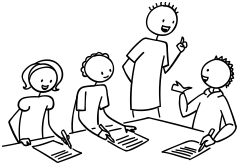
7. Do the “Past irregular verbs 2” worksheet
Give out the worksheets and have everyone match up the pictures with the verb forms by writing numbers in the boxes. Circulate as everyone is working away, and ask lots of questions (e.g. What’s this?, Did you ride your bike yesterday?, etc.). When everyone has finished, go around the class asking everybody to tell you some things they did yesterday.
8. Play “Pass the cards”
This is the same as pass the parcel but with flashcards instead of a parcel. Sit everyone in a large circle (or for really large classes, in a few circles). Give everybody a verb flashcard – give out all of the irregular verb cards first and then use the regular verb cards if you have more than 16 students. Play some music (such as the song from this lesson or a previous lesson) as everyone passes the cards around the circle. Suddenly stop the music. Students should use the card that they are holding to make a sentence, such as “Yesterday, I read a book”. If you have a small enough class, each student can say the sentence to the teacher. For larger classes this will take too long, so have students say the sentence to a person sitting next to them. Then start the music and continue passing the cards, stopping from time to time to say sentences.
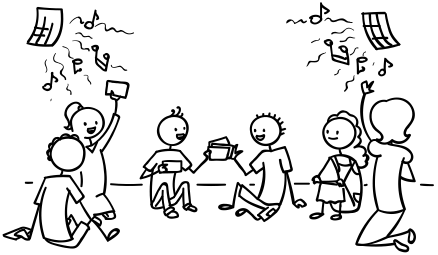
9. Make a poster picture story
To finish the lesson, your students are going to make a simple story called “My day yesterday” using pictures – and create a poster with it. You will need a large sheet of paper (e.g. A3) or construction paper / card for each pair of students, as well as lots of old magazines, [hide_on_uk]catalogs[/hide_on_uk][hide_on_us]catalogues[/hide_on_us], newspapers, etc. You’ll also need scissors and glue. It is worthwhile making an example before class so you can show students exactly what to do.

Put your students into pairs and give each pair a sheet of paper or card. On the board write, “My day yesterday” and get everybody to write this at the top of their sheet. Then tell everyone they are going to stick on pictures of things they did yesterday and write sentences. Model this by taking a magazine and finding a picture (e.g. someone riding a bike), then cut it out and glue it to your sheet. Under the picture write “Yesterday, I rode my bike”.
Now, leave everyone to get on with the activity. Circulate and help out with vocab – it is fine for your students to use pictures requiring different verbs from the one learned in the last few lessons (e.g. skiing, cook, etc.) – it is a chance to teach students new verbs! Give students around 10 minutes to create their posters.
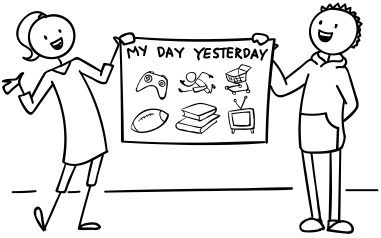
Finally, have each pair, in turn, hold up their posters and tell the class what they did yesterday. You can pin the posters to the walls – this can be used for a review activity in your next lesson!
Wrap up:
Assign homework: “My day yesterday” worksheet
Students will have to write about what they did yesterday. This task may not be straight forward for everyone so it is worth modelling – hold up the sheet and fill in the blanks with your own answers to show what to do. An example answer is as follows:
I woke up at 7 o’clock.
I ate toast and jam for breakfast.
Then I went to school.
After school I came home.
In the evening I watched TV
and I did my homework
and I read a book.
For dinner I ate pasta.
I went to bed and I slept all night.
Click for wrap up suggestions for the end of your lessons

1. Assign homework
Each week give out a homework worksheet for your students to take home. Hold up the homework worksheet and model how to do it. Give out the worksheets and say, “Put your homework in your bags”.

2. Do “Quick check”
Time to leave the class. Make sure everything is put away and the students have gathered their belongings. Have them line up at the door and place yourself between the door and the students. For each student check one new word or phrase, for example:
- hold up an object or flashcard (such as an item of clothing) and ask, “What’s this?”
- ask a question from the lesson (e.g. “Where do you live?”, “Do you like bananas?”, “Can you play chess?”, etc.)
When they give you the correct answer say goodbye and let them leave. If their answer is wrong, have them go back to the end of the line – they will have to try again once they reach the front!
Other lesson plans
Actions, verbs & tenses:
- Can – for ability
- Morning routines
- Daily routines & times of the day
- Actions – Present continuous
- Future plans using “going to”
- Past tense activities – Regular verbs
- Past tense activities – Irregular verbs: Part 1
- Past tense activities – Irregular verbs: Part 2
Adjectives:
- Describing people
- Describing things
- Comparing things (Comparative adjectives)
- Comparing things (Superlative adjectives)
Adverbs:
Alphabet:
Animals:
Body:
Classroom:
Clothes:
Colors:
Colours:
Directions:
Family:
Feelings & emotions:
Food:
Health & sickness:
Holidays & festivals:
Jobs:
Likes, dislikes & favorites:
Likes, dislikes & favourites:
- Likes & dislikes
- [hide_on_uk]Favorites[/hide_on_uk][hide_on_us]Favourites[/hide_on_us] and asking why
Nature & Our world:
Numbers:
Places & where we live:
Prepositions of location:
Pronouns:
Shapes:
Shopping:
Sports:
Time, days, months, seasons:
Toys:
Transport & travel:
Weather:




